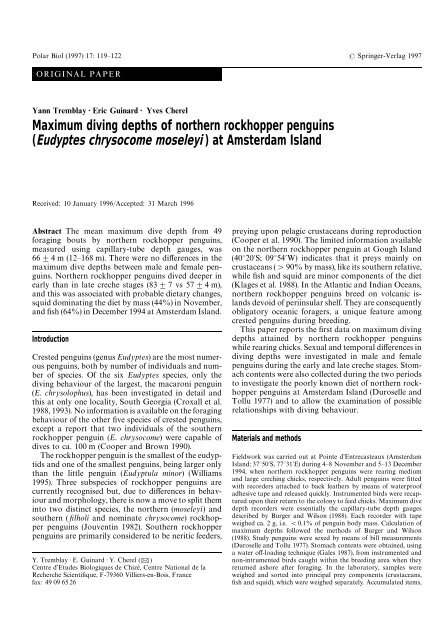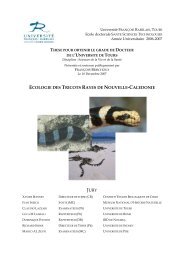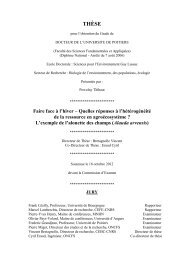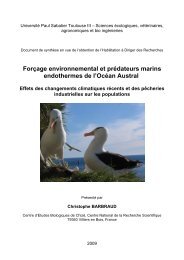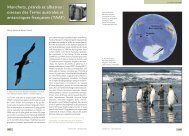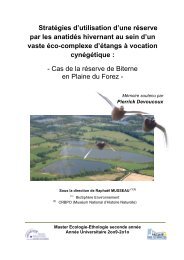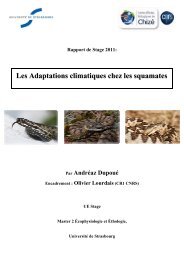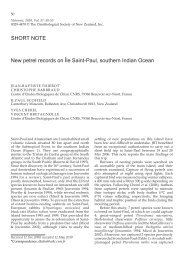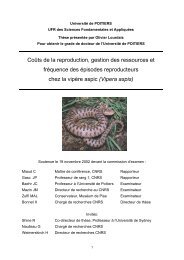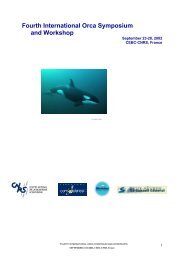Maximum diving depths of northern rockhopper penguins ... - CEBC
Maximum diving depths of northern rockhopper penguins ... - CEBC
Maximum diving depths of northern rockhopper penguins ... - CEBC
You also want an ePaper? Increase the reach of your titles
YUMPU automatically turns print PDFs into web optimized ePapers that Google loves.
Polar Biol (1997) 17: 119—122 � Springer-Verlag 1997<br />
ORIGINAL PAPER<br />
Yann Tremblay · Eric Guinard · Yves Cherel<br />
<strong>Maximum</strong> <strong>diving</strong> <strong>depths</strong> <strong>of</strong> <strong>northern</strong> <strong>rockhopper</strong> <strong>penguins</strong><br />
(Eudyptes chrysocome moseleyi ) at Amsterdam Island<br />
Received: 10 January 1996/Accepted: 31 March 1996<br />
Abstract The mean maximum dive depth from 49<br />
foraging bouts by <strong>northern</strong> <strong>rockhopper</strong> <strong>penguins</strong>,<br />
measured using capillary-tube depth gauges, was<br />
66$4 m (12—168 m). There were no differences in the<br />
maximum dive <strong>depths</strong> between male and female <strong>penguins</strong>.<br />
Northern <strong>rockhopper</strong> <strong>penguins</strong> dived deeper in<br />
early than in late creche stages (83$7 vs57$4 m),<br />
and this was associated with probable dietary changes,<br />
squid dominating the diet by mass (44%) in November,<br />
and fish (64%) in December 1994 at Amsterdam Island.<br />
Introduction<br />
Crested <strong>penguins</strong> (genus Eudyptes) are the most numerous<br />
<strong>penguins</strong>, both by number <strong>of</strong> individuals and number<br />
<strong>of</strong> species. Of the six Eudyptes species, only the<br />
<strong>diving</strong> behaviour <strong>of</strong> the largest, the macaroni penguin<br />
(E. chrysolophus), has been investigated in detail and<br />
this at only one locality, South Georgia (Croxall et al.<br />
1988, 1993). No information is available on the foraging<br />
behaviour <strong>of</strong> the other five species <strong>of</strong> crested <strong>penguins</strong>,<br />
except a report that two individuals <strong>of</strong> the southern<br />
<strong>rockhopper</strong> penguin (E. chrysocome) were capable <strong>of</strong><br />
dives to ca. 100 m (Cooper and Brown 1990).<br />
The <strong>rockhopper</strong> penguin is the smallest <strong>of</strong> the eudyptids<br />
and one <strong>of</strong> the smallest <strong>penguins</strong>, being larger only<br />
than the little penguin (Eudyptula minor) (Williams<br />
1995). Three subspecies <strong>of</strong> <strong>rockhopper</strong> <strong>penguins</strong> are<br />
currently recognised but, due to differences in behaviour<br />
and morphology, there is now a move to split them<br />
into two distinct species, the <strong>northern</strong> (moseleyi) and<br />
southern ( filholi and nominate chrysocome) <strong>rockhopper</strong><br />
<strong>penguins</strong> (Jouventin 1982). Southern <strong>rockhopper</strong><br />
<strong>penguins</strong> are primarily considered to be neritic feeders,<br />
Y. Tremblay · E. Guinard · Y. Cherel ( )<br />
Centre d’Etudes Biologiques de Chizé, Centre National de la<br />
Recherche Scientifique, F-79360 Villiers-en-Bois, France<br />
fax: 49 09 65 26<br />
preying upon pelagic crustaceans during reproduction<br />
(Cooper et al. 1990). The limited information available<br />
on the <strong>northern</strong> <strong>rockhopper</strong> penguin at Gough Island<br />
(40°20�S; 09°54�W) indicates that it preys mainly on<br />
crustaceans ('90% by mass), like its southern relative,<br />
while fish and squid are minor components <strong>of</strong> the diet<br />
(Klages et al. 1988). In the Atlantic and Indian Oceans,<br />
<strong>northern</strong> <strong>rockhopper</strong> <strong>penguins</strong> breed on volcanic islands<br />
devoid <strong>of</strong> periinsular shelf. They are consequently<br />
obligatory oceanic foragers, a unique feature among<br />
crested <strong>penguins</strong> during breeding.<br />
This paper reports the first data on maximum <strong>diving</strong><br />
<strong>depths</strong> attained by <strong>northern</strong> <strong>rockhopper</strong> <strong>penguins</strong><br />
while rearing chicks. Sexual and temporal differences in<br />
<strong>diving</strong> <strong>depths</strong> were investigated in male and female<br />
<strong>penguins</strong> during the early and late creche stages. Stomach<br />
contents were also collected during the two periods<br />
to investigate the poorly known diet <strong>of</strong> <strong>northern</strong> <strong>rockhopper</strong><br />
<strong>penguins</strong> at Amsterdam Island (Duroselle and<br />
Tollu 1977) and to allow the examination <strong>of</strong> possible<br />
relationships with <strong>diving</strong> behaviour.<br />
Materials and methods<br />
Fieldwork was carried out at Pointe d’Entrecasteaux (Amsterdam<br />
Island; 37°50�S, 77°31�E) during 4—8 November and 5—13 December<br />
1994, when <strong>northern</strong> <strong>rockhopper</strong> <strong>penguins</strong> were rearing medium<br />
and large creching chicks, respectively. Adult <strong>penguins</strong> were fitted<br />
with recorders attached to back feathers by means <strong>of</strong> waterpro<strong>of</strong><br />
adhesive tape and released quickly. Instrumented birds were recaptured<br />
upon their return to the colony to feed chicks. <strong>Maximum</strong> dive<br />
depth recorders were essentially the capillary-tube depth gauges<br />
described by Burger and Wilson (1988). Each recorder with tape<br />
weighed ca. 2 g, i.e. (0.1% <strong>of</strong> penguin body mass. Calculation <strong>of</strong><br />
maximum <strong>depths</strong> followed the methods <strong>of</strong> Burger and Wilson<br />
(1988). Study <strong>penguins</strong> were sexed by means <strong>of</strong> bill measurements<br />
(Duroselle and Tollu 1977). Stomach contents were obtained, using<br />
a water <strong>of</strong>f-loading technique (Gales 1987), from instrumented and<br />
non-intrumented birds caught within the breeding area when they<br />
returned ashore after foraging. In the laboratory, samples were<br />
weighed and sorted into principal prey components (crustaceans,<br />
fish and squid), which were weighed separately. Accumulated items,
120<br />
including squid beaks, were excluded from the analysis. Species<br />
composition <strong>of</strong> the food was determined from otoliths and skeletal<br />
remains <strong>of</strong> fish, external features and/or beaks <strong>of</strong> squid, and exoskeletons<br />
<strong>of</strong> crustaceans. Data were compared for statistically significant<br />
differences using Peritz’s F test. Values are means$SE.<br />
Results<br />
Of 148 recorders that were attached, 70 (47%) were<br />
recovered and 68 (46%) gave easily readable maximum<br />
dive <strong>depths</strong>. All <strong>penguins</strong> were recaptured 1 (n"30)—7<br />
(n"3) days after being equipped. There was no significant<br />
correlation between time spent at sea and maximum<br />
depth reached.<br />
Forty-nine gauges indicated <strong>depths</strong> deeper than<br />
10 m (Fig. 1). The 19 remaining gauges showed <strong>depths</strong><br />
<strong>of</strong> less <strong>of</strong> 10 m with a mean value <strong>of</strong> 3.2$0.5 m<br />
(0.8—7.8 m). Such low <strong>depths</strong> were probably reached<br />
while <strong>penguins</strong> bathed and preened at sea in the morning<br />
near shore. Two instrumented birds that reached<br />
<strong>depths</strong> <strong>of</strong> only 0.8 and 1.6 m had only accumulated<br />
items in their stomach, and very recent unpublished<br />
data using time-depth recorders indicated that maximum<br />
<strong>diving</strong> <strong>depths</strong> during foraging trips were always<br />
below 10 m. The <strong>diving</strong> <strong>depths</strong> shallower than 10 m<br />
were therefore discarded from the analysis.<br />
The maximum <strong>diving</strong> <strong>depths</strong> reached by <strong>northern</strong><br />
<strong>rockhopper</strong> <strong>penguins</strong> during chick rearing ranged from<br />
12 to 168 m (n"49) and averaged 66$4 m. Thirteen<br />
birds (27%) dived between 60 and 70 m, six birds dived<br />
deeper than 100 m (12%), and one female reached<br />
168 m (Fig. 1). In agreement with other studies using<br />
maximum depth recorders (Montague 1985;<br />
Whitehead 1989; Seddon and Van Heezik 1990;<br />
Scolaro and Suburo 1991; Bost et al. 1994), there was<br />
no difference between the overall mean dive <strong>depths</strong> <strong>of</strong><br />
males (64$5m, n"26) and females (66$7m,<br />
n"23). Within the creche period, adult <strong>northern</strong><br />
<strong>rockhopper</strong> <strong>penguins</strong> dived deeper (P(0.01) in<br />
November (83$7m, n"17) than in December<br />
(57$4m,n"32).<br />
Stomach samples collected in November did not<br />
differ significantly in mean mass from those collected in<br />
December (51$9g, n"9, and 45$12 g, n"12, respectively).<br />
Three prey classes, crustaceans, squid and<br />
fish, were important by mass during the two periods<br />
(Fig. 2). By number, crustaceans formed the bulk <strong>of</strong> the<br />
prey both in November (98%) and December (94%),<br />
but, owing to their larger size, squid dominated the diet<br />
by mass in November (44%) and fish in December<br />
(64%) (Fig. 2).<br />
There were major differences in the prey species<br />
eaten during the two periods. The euphausiids<br />
¹hysanoessa gregaria and Nematoscelis megalops<br />
accounted for more than 99% <strong>of</strong> the crustaceans eaten<br />
in November and December, respectively. Mendosoma<br />
lineatum (Latrididae) was the main fish prey in<br />
Fig. 1 Frequency distribution <strong>of</strong> 68 maximum dive <strong>depths</strong> by <strong>northern</strong><br />
<strong>rockhopper</strong> <strong>penguins</strong> during chick rearing at Amsterdam Island<br />
in November/December 1994<br />
Fig. 2 Proportion by mass <strong>of</strong> crustacea, squid and fish in the diet <strong>of</strong><br />
<strong>northern</strong> <strong>rockhopper</strong> <strong>penguins</strong> feeding chicks at Amsterdam Island<br />
in November and December 1994 (n"9 and 12 samples, respectively)<br />
November but it was replaced by Scomberesox saurus<br />
(Scomberesocidae) in December. Ommastrephid squid<br />
(probably ¹odarodes filippovae) was the only<br />
cephalopod prey identified in November, while numerous<br />
very small squids (probably Brachioteuthis sp.)<br />
dominated the cephalopods consumed by number<br />
(90%) in December.<br />
Discussion<br />
Though recorders used in this study only indicated the<br />
deepest dives <strong>of</strong> the foraging trips with no other information<br />
on underwater behaviour, they give a first
insight into the <strong>diving</strong> capabilities <strong>of</strong> <strong>northern</strong> <strong>rockhopper</strong><br />
<strong>penguins</strong>. From an ecological point <strong>of</strong> view, the<br />
maximum dive depth recorded (168 m) demonstrates<br />
that <strong>northern</strong> <strong>rockhopper</strong> <strong>penguins</strong> are able to exploit<br />
deep water prey, even if it may represent a rare dive<br />
beyond the birds’ normal foraging <strong>depths</strong>.<br />
The <strong>diving</strong> abilities <strong>of</strong> <strong>penguins</strong> are generally related<br />
to body mass, larger animals being physiologically capable<br />
<strong>of</strong> longer and deeper dives (Kooyman and Kooyman<br />
1995). Being the second smallest penguin species<br />
so far investigated, it is interesting to compare our data<br />
to the allometric equation <strong>of</strong> Wilson (1995), relating<br />
maximum <strong>diving</strong> depth (x) to body mass (y) for <strong>penguins</strong><br />
(y"47.6#18.0 x). With a mean body mass <strong>of</strong><br />
2.66 kg for males and females combined, the predicted<br />
maximum dive is 95 m for <strong>northern</strong> <strong>rockhopper</strong> <strong>penguins</strong>.<br />
This value is much lower than maximum <strong>depths</strong><br />
recorded in this study, where 6 birds (12%) dived<br />
deeper than 100 m. The maximum depth <strong>of</strong> dives is<br />
primarily determined by the anaerobic capabilities <strong>of</strong><br />
swimming muscles (Baldwin 1988). Physiological evidence<br />
shows that <strong>rockhopper</strong> penguin muscles have<br />
lower anaerobic capacities than those <strong>of</strong> emperor, king,<br />
Adélie and gentoo <strong>penguins</strong>, similar capacities to those<br />
<strong>of</strong> the royal penguin (Eudyptes schlegeli) but higher<br />
capacities than those <strong>of</strong> the little penguin (Baldwin<br />
1988). Muscle biochemistry appears to reflect, therefore,<br />
the maximum <strong>diving</strong> <strong>depths</strong> <strong>of</strong> free-living <strong>penguins</strong><br />
(Table 1). We can thus predict that the maximum<br />
<strong>diving</strong> <strong>depths</strong> <strong>of</strong> some penguin species heavier than the<br />
<strong>rockhopper</strong> penguin are likely to be underestimated.<br />
Underestimation <strong>of</strong> the <strong>diving</strong> ability results probably<br />
from the scarcity <strong>of</strong> dives performed near the physiological<br />
limits. Diving depth is also usually related to prey<br />
location in the water column and/or to bottom topography,<br />
both commonly occurring at <strong>depths</strong> shallower than<br />
the maximum <strong>diving</strong> capacity <strong>of</strong> <strong>penguins</strong>.<br />
<strong>Maximum</strong> <strong>depths</strong> for Spheniscus species and Adélie<br />
<strong>penguins</strong> change according to location and time <strong>of</strong><br />
the year (Whitehead 1989; Wilson and Wilson 1990;<br />
Scolaro and Suburo 1991). The most likely explanation<br />
for such changes in <strong>diving</strong> behaviour is differences in<br />
the availability <strong>of</strong> prey. For example, gentoo <strong>penguins</strong><br />
feeding on pelagic crustaceans or benthic fish exhibit<br />
shallow or deep dives, respectively (Croxall et al. 1988),<br />
and macaroni and king <strong>penguins</strong> follow the diel migration<br />
<strong>of</strong> their prey and/or are restricted in their dive<br />
<strong>depths</strong> by light availability (Croxall et al. 1988; Kooyman<br />
et al. 1992; Wilson et al. 1993). As demonstrated<br />
for Adélie <strong>penguins</strong> (Whitehead 1989), <strong>northern</strong> <strong>rockhopper</strong><br />
<strong>penguins</strong> reached greater <strong>depths</strong> at the beginning<br />
than at the end <strong>of</strong> the creche period. Diet analysis<br />
indicated that this difference in foraging behaviour was<br />
concomitant with a marked shift in prey species.<br />
In November 1994, the main prey <strong>of</strong> <strong>rockhopper</strong><br />
<strong>penguins</strong> at Amsterdam Island were identical to<br />
those eaten at Gough Island during three successive<br />
November months (Klages et al. 1988). The proportion<br />
Table 1 <strong>Maximum</strong> <strong>diving</strong> <strong>depths</strong> <strong>of</strong> <strong>penguins</strong>. (Abbreviations: ADG autoradiographic depth gauges; MDR maximum dive depth recorders; ¹DR time/depth recorders)<br />
Species Number <strong>Maximum</strong> Method Locality Reference<br />
<strong>of</strong> birds <strong>diving</strong><br />
<strong>depths</strong> (m)<br />
King penguin (Aptenodytes patagonicus) ? 323 TDR Crozet Islands Pütz in Wilson (1995)<br />
Emperor penguin (Aptenodytes forsteri) 5 534 TDR Ross Sea, Antarctica Kooyman and Kooyman (1995)<br />
Gentoo penguin (Pygoscelis papua) 15 210 MDR Crozet Islands Bost et al. (1994)<br />
Ade´ lie penguin (Pygoscelis adeliae) 58 175 MDR Prydz Bay, Antarctica Whitehead (1989)<br />
Chinstrap penguin (Pygoscelis antarctica) 4 121 TDR South Shetland Islands Bengtson et al. (1993)<br />
Southern <strong>rockhopper</strong> penguin (Eudyptes chrysocome filholi) 2 c100 MDR Marion Island Cooper and Brown (1990)<br />
Northern <strong>rockhopper</strong> penguin (Eudyptes chrysocome moseleyi) 49 168 MDR Amsterdam Island This study<br />
Macaroni penguin (Eudyptes chrysolophus) 4 115 TDR South Georgia Croxall et al. (1993)<br />
Yellow-eyed penguin (Megadyptes antipodes) 43 56 MDR New Zealand Seddon and Van Heezik (1990)<br />
Little penguin (Eudyptula minor) 32 69 MDR Australia Montague (1985)<br />
African or jackass penguin (Spheniscus demersus) 15 130 ADG South Africa Wilson (1985)<br />
Humboldt penguin (Spheniscus humboldti) 18 80 MDR Chile Duffy et al. in Wilson and Wilson (1990)<br />
Magellanic penguin (Spheniscus magellanicus) 63 90 MDR Argentina Scolaro and Suburo (1991)<br />
121
122<br />
by mass <strong>of</strong> prey classes, however, differed greatly. Similar<br />
to most other localities (Cooper et al. 1990), crustaceans<br />
predominated at Gough Island ('90% by<br />
mass), while they accounted for 31% <strong>of</strong> the diet at<br />
Amsterdam Island. The predominance <strong>of</strong> squid at that<br />
time is only comparable to the diet <strong>of</strong> <strong>rockhopper</strong><br />
<strong>penguins</strong> at the Falkland Islands where cephalopods<br />
form the bulk <strong>of</strong> the food (53% by mass) during the<br />
brooding period (Croxall et al. 1985).<br />
The complete shift in prey species between early and<br />
late creche stages in <strong>northern</strong> <strong>rockhopper</strong> <strong>penguins</strong> at<br />
Amsterdam Island appears unique among crested <strong>penguins</strong><br />
and requires further investigation in subsequent<br />
years. With only minor exceptions, all prey eaten by<br />
<strong>rockhopper</strong> <strong>penguins</strong> are pelagic swarming species<br />
(Cooper et al. 1990). Our findings confirm this general<br />
trend. The euphausiids ¹hysanoessa gregaria and<br />
Nematocelis megalops occupy near-surface waters <strong>of</strong><br />
the Indian Ocean, where they are abundant between<br />
30 and 41°S, and 35 and 40°S, respectively (Brinton and<br />
Gopalakrishnan 1973; Casanova 1980), and Scomberesox<br />
saurus is an epipelagic fish found in the open<br />
ocean in cold- to warm-temperate waters between 25<br />
and 40°S at the latitude <strong>of</strong> Amsterdam Island (Hubbs<br />
and Wisner 1980). However, and as previously noted at<br />
Macquarie Island (Hindell 1988), <strong>rockhopper</strong> <strong>penguins</strong><br />
may also feed on inshore species, indicating that they<br />
spend some time foraging close to the breeding colony.<br />
The latridid Mendosoma lineatum is a typical example<br />
<strong>of</strong> this kind <strong>of</strong> prey since it is a coastal fish around<br />
both Gough and Amsterdam Islands (Duhamel 1989;<br />
Andrew et al. 1995).<br />
The dietary shift from the inshore M. lineatum to the<br />
<strong>of</strong>fshore S. saurus, together with the monthly difference<br />
in the mean maximum depth reached, are indicative <strong>of</strong><br />
a change in food and feeding ecology between November<br />
and December. A better knowledge <strong>of</strong> this change<br />
necessitates the use <strong>of</strong> more sophisticated devices,<br />
which allow determination <strong>of</strong> foraging parameters such<br />
as the duration, depth and pr<strong>of</strong>ile <strong>of</strong> each dive.<br />
Acknowledgements The authors thank Rory Wilson for his helpful<br />
comments on the text. This work was supported financially and<br />
logistically by the Institut Franiais pour la Recherche et la Technologie<br />
Polaires/Terres Australes et Antarctiques Franiaises.<br />
References<br />
Andrew TG, Hecht T, Heemstra PC, Lutjeharms JRE (1995) Fishes<br />
<strong>of</strong> the Tristan da Cunha group and Gough Island, South Atlantic<br />
Ocean. Ichthyol Bull 63:1—43<br />
Baldwin J (1988) Predicting the swimming and <strong>diving</strong> behaviour <strong>of</strong><br />
<strong>penguins</strong> from muscle biochemistry. Hydrobiologia 165:255—261<br />
Bengtson JL, Croll DA, Goebel ME (1993) Diving behaviour <strong>of</strong><br />
chinstrap <strong>penguins</strong> at Seal Island. Antarct Sci 5:9—15<br />
Bost CA, Pu¨ tz K, Lage J (1994) <strong>Maximum</strong> <strong>diving</strong> depth and <strong>diving</strong><br />
patterns <strong>of</strong> the gentoo penguin Pygoscelis papua at the Crozet<br />
Islands. Mar Ornithol 22:237—244<br />
Brinton E, Gopalakrishnan K (1973) The distribution <strong>of</strong> Indian<br />
Ocean euphausiids. Ecol Stud Anal Synth 3:357—382<br />
Burger AE, Wilson RP (1988) Capillary-tube depth gauges for <strong>diving</strong><br />
animals: an assessment <strong>of</strong> their accuracy and applicability.<br />
J Field Ornithol 59:345—354<br />
Casanova B (1980) Evolution spatiale et structurale des peuplements<br />
d’euphausiacés de l’Antarctique au golfe d’Aden. Invest Pesq<br />
44:377—394<br />
Cooper J, Brown CR (1990) Ornithological research at the sub-<br />
Antarctic Prince Edward Islands: a review <strong>of</strong> achievements. S Afr<br />
J Antarct Res 20:40—57<br />
Cooper J, Brown CR, Gales RP, Hindell MA, Klages NTW, Moors<br />
PJ, Pemberton D, Ridoux V, Thompson KR, Van Heezik YM<br />
(1990) Diets and dietary segregation <strong>of</strong> crested <strong>penguins</strong> (Eudyptes).<br />
In: Davis LS, Darby JT (eds) Penguin biology. Academic<br />
Press, San Diego, pp 131—156<br />
Croxall JP, Prince PA, Baird A, Ward P (1985) The diet <strong>of</strong> the<br />
southern <strong>rockhopper</strong> penguin Eudyptes chrysocome chrysocome at<br />
Beaucheˆ ne Island, Falkland Islands. J Zool Lond 206:485—496<br />
Croxall JP, Davis RW, O’Connell MJ (1988) Diving patterns in<br />
relation to diet <strong>of</strong> gentoo and macaroni <strong>penguins</strong> at South<br />
Georgia. Condor 90:157—167<br />
Croxall JP, Briggs DR, Kato A, Naito Y, Watanuki Y, Williams TD<br />
(1993) Diving patterns and performance in the macaroni penguin<br />
Eudyptes chrysolophus. J Zool Lond 230:31—47<br />
Duhamel G (1989) Ichty<strong>of</strong>aune des Iles Saint-Paul et Amsterdam<br />
(Océan Indien Sud). Mésogée 49:21—47<br />
Duroselle T, Tollu B (1977) The <strong>rockhopper</strong> penguin (Eudyptes<br />
chrysocome moseleyi) <strong>of</strong> Saint Paul and Amsterdam Islands. In:<br />
Llano GA (ed) Adaptations within Antarctic ecosystems, Proceedings<br />
<strong>of</strong> the third SCAR Symposium on Antarctic biology.<br />
Smithsonian Institution, Washington, DC, pp 579—604<br />
Gales RP (1987) Validation <strong>of</strong> the stomach-flushing technique for<br />
obtaining stomach contents <strong>of</strong> <strong>penguins</strong>. Ibis 129:335—343<br />
Hindell MA (1988) The diet <strong>of</strong> the <strong>rockhopper</strong> penguin Eudyptes<br />
chrysocome at Macquarie Island. Emu 88:227—233<br />
Hubbs CL, Wisner RL (1980) Revision <strong>of</strong> the sauries (Pisces, Scomberesocidae)<br />
with descriptions <strong>of</strong> two new genera and one new<br />
species. Fish Bull 77:521—566<br />
Jouventin P (1982) Visual and vocal signals in <strong>penguins</strong>, their<br />
evolution and adaptive characters. Adv Ethol 24:1—149<br />
Klages NT, Brooke ML de, Watkins BP (1988) Prey <strong>of</strong> <strong>northern</strong><br />
<strong>rockhopper</strong> <strong>penguins</strong> at Gough Island, South Atlantic Ocean.<br />
Ostrich 59:162—165<br />
Kooyman GL, Kooyman TG (1995) Diving behavior <strong>of</strong> emperor<br />
<strong>penguins</strong> nurturing chicks at Coulman Island, Antarctica. Condor<br />
97:536—549<br />
Kooyman GL, Cherel Y, Le Maho Y, Croxall JP, Thorson PH,<br />
Ridoux V, Kooyman CA (1992) Diving behavior and energetics<br />
during foraging cycles in king <strong>penguins</strong>. Ecol Monogr<br />
62:143—163<br />
Montague T (1985) A maximum dive recorder for little <strong>penguins</strong>.<br />
Emu 85:264—267<br />
Scolaro JA, Suburo AM (1991) <strong>Maximum</strong> <strong>diving</strong> <strong>depths</strong> <strong>of</strong> the<br />
magellanic penguin. J Field Ornithol 62:204—210<br />
Seddon PJ, Van Heezik Y (1990) Diving <strong>depths</strong> <strong>of</strong> the yellow-eyed<br />
penguin Megadyptes antipodes. Emu 90:53—57<br />
Whitehead MD (1989) <strong>Maximum</strong> <strong>diving</strong> <strong>depths</strong> <strong>of</strong> the Adélie penguin,<br />
Pygoscelis adeliae, during the chick rearing period, in Prydz<br />
Bay, Antarctica. Polar Biol 9:329—332<br />
Williams TD (1995) The <strong>penguins</strong>. Oxford University Press, Oxford<br />
Wilson RP (1985) The jackass penguin (Spheniscus demersus) as<br />
a pelagic predator. Mar Ecol Prog Ser 25:219—227<br />
Wilson RP (1995) Foraging ecology. In: Williams TD (ed) The<br />
<strong>penguins</strong>. Oxford University Press, Oxford, pp 81—106<br />
Wilson RP, Wilson MPT (1990) Foraging ecology <strong>of</strong> breeding<br />
Spheniscus <strong>penguins</strong>. In: Davis LS, Darby JT (eds) Penguin<br />
biology. Academic Press, San Diego, pp 181—206<br />
Wilson RP, Puetz K, Bost CA, Culik BM, Bannasch R, Reins T,<br />
Adelung D (1993) Diel dive depth in <strong>penguins</strong> in relation to diel<br />
vertical migration <strong>of</strong> prey: whose dinner by candlelight? Mar<br />
Ecol Prog Ser 94:101—104


